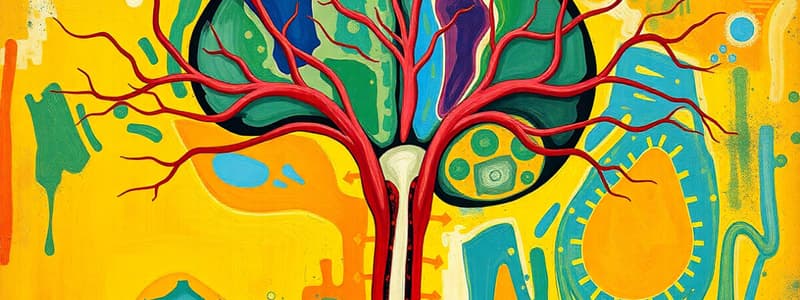Podcast
Questions and Answers
What type of dysarthria is characterized by low pitch and a strained-strangled quality in voice?
What type of dysarthria is characterized by low pitch and a strained-strangled quality in voice?
- Mixed Dysarthria
- Ataxic Dysarthria
- Flaccid Dysarthria
- Spastic Dysarthria (correct)
Which of the following motor weakness terms indicates no movement in both of the legs?
Which of the following motor weakness terms indicates no movement in both of the legs?
- Hemiparesis
- Hemiplegia
- Quadriplegia
- Paraplegia (correct)
Lesions to the corticobulbar tract will typically result in which combination of signs?
Lesions to the corticobulbar tract will typically result in which combination of signs?
- No signs at all
- Only LMN signs
- Only UMN signs
- Both UMN and LMN signs (correct)
What is a common speech characteristic of Flaccid Dysarthria?
What is a common speech characteristic of Flaccid Dysarthria?
Which term designates weakness (partial paralysis) affecting one side of the body?
Which term designates weakness (partial paralysis) affecting one side of the body?
Flashcards are hidden until you start studying
Study Notes
CN I Olfactory Nerve
- Sensory nerve responsible for sense of smell
- Nerve endings are triggered by odor molecules
- Nerve impulse sent to olfactory bulb
- Terminates in olfactory cortex (inferior/medial temporal lobe)
- Clinical concerns: anosmia, hyposmia, hyperosmia
- Individuals with traumatic brain injury (TBI) may experience smell complaints due to damage to CN I tract at the base of the skull
CN II Optic Nerve
- Sensory nerve responsible for vision
- Originates in photoreceptor layer of retina, which transduces light energy into electrical signals
- Travels through optic nerve, optic chiasm where fibers cross over, and optic tract
- Terminates in occipital lobe
- Clinical concerns: visual field cuts, which may occur in aphasia or TBI due to damage to optic radiations
CN III Occulomotor Nerve
- Motor nerve responsible for eye movements, pupillary light reflex, and accommodation reflex
- Originates in oculomotor nucleus and Edinger-Westphal nucleus
- Fibers travel ventrally through brainstem
- Terminates in various eye muscles, pupillary sphincter, and ciliary muscle
- Pupillary light reflex controls amount of light entering eye
- Accommodation reflex adjusts lens shape for near vision and convergence
CN IV Trochlear Nerve
- Motor nerve responsible for eye movements
- Originates in trochlear nucleus
- Fibers travel ventrally through the brainstem
- Terminates in superior oblique muscle
- Controls downward and inward eye movement
Corticobulbar Tract
- The corticobulbar tract consists of upper motor neuron (UMN) fibers that connect the cerebral cortex to the motor nuclei of the cranial nerves.
- The UMNs in the corticobulbar tract originate in the cerebral cortex and descend to the brainstem.
- The lower motor neurons (LMN) in the corticobulbar tract originate in the brainstem and project to the muscle units of various muscles.
Lesions to the Corticobulbar Tract
- Lesions to the corticobulbar tract can result in both upper motor neuron (UMN) and lower motor neuron (LMN) lesion signs.
- UMN lesion signs differ from LMN lesion signs.
Dysarthrias
- Dysarthrias are motor speech disorders that result from impairments in various systems due to damage within the central nervous system (CNS) or peripheral nervous system (PNS).
- Dysarthrias affect the following systems:
- Respiratory
- Phonatory (voice)
- Resonatory
- Articulatory (speech)
- Prosodic
Spastic Dysarthria
- Spastic dysarthria is due to damage to the upper motor neuron (UMN) system.
- Prominent speech characteristics include:
- Low pitch
- Slow rate
- Strained-strangled quality
Flaccid Dysarthria
- Flaccid dysarthria is due to damage to the lower motor neuron (LMN) system or the motor unit.
- Prominent speech characteristics include:
- Hypernasality
- Continuous breathiness
- Nasal emission
- Audible inspiration
- Short phrases
Motor Weakness Terms
- Paresis refers to weakness (partial paralysis).
- -plegia refers to no movement or paralysis.
- Hemi- refers to one side of the body.
- Para- refers to both legs.
- Quadri- refers to all four limbs.
Motor Weakness Terminology
- Hemiplegia: No movements on one side of the body.
- Hemiparesis: Weakness in movements on one side of the body.
- Paraplegia: No movements in both legs.
- Quadriplegia: No movements in all four limbs.
Studying That Suits You
Use AI to generate personalized quizzes and flashcards to suit your learning preferences.




